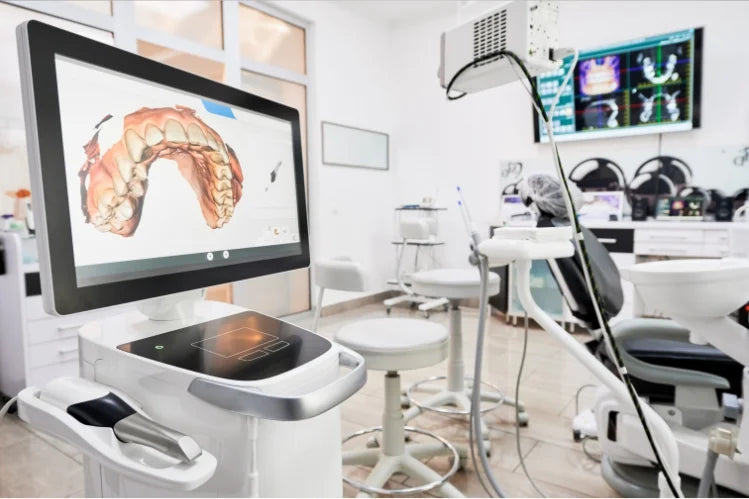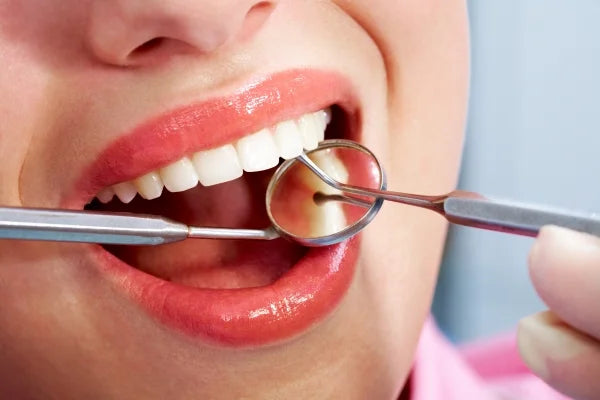
Table of contents
- Bite Correction: All Your Options Discussed
Even though the human body is a system that is perfectly built to do its essential jobs, many things can affect how certain body parts form and grow. So, different people can have different types of bites that change how their teeth fit together.
The term "malocclusion" in dentistry refers to an improper alignment of the tooth arches and jaw bones. This can lead to some health problems. the cause of some health issues.
We look at the different types of bites, what makes each one unique, and the problems that can be fixed with dental work.
Understanding Bite Issues
Before we discuss the correction methods, it's important to understand what constitutes a "bite" and what problems can arise when it's misaligned.

What is a Bite?
The term "bite" in dentistry refers to how the teeth close together in the mouth. For the bite to function properly, the upper and lower teeth must fit together perfectly when the mouth is closed.
A variety of issues with the teeth and jaw structure can result from an uneven bite.
Tooth appearance is not the only factor associated with an improper bite. It can cause headaches, neck or ear pain, trouble chewing food, and even serious or minor dental health issues in its sufferers.
Different Types of Bite
If you have a bad bite, it can be hard to chew, which can make it more likely that food will get stuck in some parts of your mouth, leading to plague, cavities, bad breath, and more. Muscular and dental issues manifest themselves over time, including but not limited to tooth decay, periodontitis, and other conditions, as well as muscle stress in the jaw region. The angle categorization based on the location of the dental arches determines the different bite forms. One considers the orientation of the upper first molars.
Class I occlusion
Often referred to as normocclusion, this is the proper position whereby the first molar should fit above and somewhat in front of the lower first molar.
Usually found in the anterior sector, a person with this type of bite may cause crowding, rotation of teeth, or other positioning abnormalities, thereby posing issues.
Class II occlusion
A bite that is classified as class II occurs when the upper first molar occludes significantly before the lower first molar.
In addition to the incorrect positioning of the molars, this type of patient frequently exhibits a poor position of the upper incisors. These incisors may be inclined toward the lips, resulting in a horizontal overbite, or the central incisors may be angled toward the inside and the lateral incisors toward the outside.
Class III Malocclusion
A Class III bite is characterized by the upper first molar being positioned below the lower first molar, in contrast to the Class II occlusion.
The lower dental arch, which is located in front of the upper dental arch, is sometimes referred to as the projecting jaw.
Common Types of Bite Misalignments
Underbite
An underbite happens when the lower jaw extends further than the upper jaw, causing the lower front teeth to sit in front of the upper ones. This misalignment can make it difficult to bite and chew properly, and it can also impact your smile and the way you speak.
Crossbite
A crossbite occurs when the upper and lower teeth don’t line up correctly, with some upper teeth sitting inside the lower teeth when you bite down. This misalignment can lead to issues with chewing and biting, and it may also affect the appearance of your smile and the health of your teeth. Effective treatment is essential for cross bite correction to prevent these issues.
Open bite
An anterior open bite happens when the back teeth come together but the upper and lower front teeth don’t overlap. This can be caused by habits like excessive thumb sucking, tongue thrusting, or mouth breathing. A posterior open bite is the opposite—when the front teeth meet, but the back teeth don’t. Both types can lead to challenges like swallowing issues, where the tongue pushes through the teeth when swallowing, and potential speech problems. Effective treatment is essential for open bite correction to prevent these issues.
Deep bite
When the upper front teeth significantly overlap the lower front teeth, they typically cover them almost fully when you bite down, resulting in a deep bite. This may lead to lower teeth biting into the roof of the mouth, while upper teeth can bite into the lower gums. Possible early enamel wear, gum disease. Effective treatment is essential for deep bite correction to prevent these issues.
Protrusion
The top jaw may be too far forward, the lower jaw may be too far back, the teeth may have grown in at an angle, or all of these things may have caused the teeth to stick out. A deep bite is a common characteristic of persons whose front teeth stick out. This can lead to upper teeth being prone to unintentional shattering; it is difficult to comfortably seal the mouth and lips, resulting in dried-out oral tissues, tooth rot, speech issues, etc.

Dental Crowding
One of the most frequent reasons individuals get braces is for crowding. It is an issue in which there is not enough room in your gums to accommodate all of your teeth. This makes your teeth twisted and your bite out of place. Because it is harder for you to keep your crooked teeth clean, this can also lead to gum health issues and tooth decay.

Gap in Teeth
When your teeth are far apart, you have spacing. Usually occurring when the jaw gives too much space for teeth to emerge, it is the reverse of dental crowding. Generally speaking, space is handled using braces much as crowding is.
Openbite
It is possible to have difficulties biting, eating, and speaking if you have an open bite, which occurs when the top and lower front teeth of your mouth do not connect. The development of the teeth as a whole is also impacted by this issue.
Why is My Bite Off?
Incorrect bites can be caused by a variety of factors:
Genetics: Often inherited, the size and form of the teeth and jaw greatly affect bite alignment. One may be more at risk if their parents or grandparents suffer from malocclusions.
Prolonged Thumb Sucking: Malocclusions can result from prolonged usage of pacifiers or bottles outside infancy and thumb sucking past the age of five.
Premature Loss of Baby Teeth: Should primary teeth be lost too early from trauma or decay, the surrounding teeth may migrate into the void and create poor alignment of the permanent teeth.
Impacted Dental Fitting: Malocclusion can be caused in part by poorly fitted dental equipment, fillings, crowns, or braces.
Missing Teeth: Teeth that don't erupt correctly from the gums—such as impacted wisdom teeth—or that are absent totally might cause space problems and misalignment of neighboring teeth.
Problems with Dental Growth: Sometimes the top and bottom jaws grow at different rates, causing underbites, overbites, or crossbites.
Dental Correction Options
Worried about your bite? Many misaligned bites can be corrected using bite correction. Common ways to repair a misaligned bite include:

Traditional Braces
Put simply, braces have been around for a long time as a reliable way to fix a misaligned bite. Bite correction braces work by putting constant pressure on the teeth to move them into the right place. They do this by attaching metal bands to each tooth and connecting them with a wire. It works well for even the most severe problems involving jaw and dental realignment and class 2 bite corrections.
Ceramic and 3D-printed braces are also options thanks to progress in technology. They are less obvious than metal braces.
| Pros | Cons |
|---|---|
| Provides comprehensive correction for both alignment and bite discrepancies. | Metal wires and brackets are highly visible |
| Can fix a wide range of dental issues | Brackets and wires may also irritate the inside of the mouth, leading to sores and ulcers. |
| Made from strong materials that can withstand significant forces, | Food particles can easily get trapped, leading to plaque buildup and an increased risk of cavities and gum disease |
Expanders
Designed to extend the upper jaw and provide more room for teeth to align correctly, palatal expanders are specialist orthodontic tools used for dental realignment and bite correction. In young patients whose jaws are still growing, this is very helpful in reducing crossbites and crowding. Fitting across numerous upper teeth in the rear of the mouth, the expander bears a screw in the middle. With regular adjustments—turns of the screw—the device progressively and gently separates the left and right portions of the upper jaw, therefore encouraging bone development over time. Usually kept in place for many months to stabilize the outcome, the device is removed once the intended enlargement is attained.
| Pros | Cons |
|---|---|
| Dental expanders are often less invasive than other orthodontic treatments, such as braces. | Wearing an expander can cause initial discomfort, especially during the activation phase. |
| Helps create space for teeth, potentially avoiding the need for tooth extractions. | Expanders can be costly, especially if they require additional orthodontic treatment. |
| Can help improve breathing by widening the nasal passages. | Maintaining good oral hygiene can be more difficult. |

Extraction of Teeth
Tooth extractions may be required for patients with significant dental crowding. To provide more room in the mouth, particular teeth are taken out with this procedure. This allows the remaining teeth to migrate and line up correctly using orthodontic teeth straightening techniques like braces. Following careful evaluation by an orthodontist, tooth extraction might be advised if the advantages of the extraction exceed the value of keeping all teeth.
Jaw Surgery
When factors other than tooth location contribute to bite misalignment, orthognathic surgery, often known as jaw surgery, is a carefully deliberated option. This surgical operation aligns the jawbones for a better bite and facial appearance. Before and after jaw surgery, orthodontic therapy is usually done. It's usually suggested for severe underbites, overbites, and asymmetries where non-surgical therapies fail. Surgery might be scary, yet it can change things when other therapies fail. This type of treatment is best for class 3 bite correction.
| Pros | Cons |
|---|---|
| Bite correction surgery offers a permanent solution to severe bite problems. | Surgery is a significant medical procedure that carries risks, such as infection, nerve damage, and complications related to anesthesia. |
| Surgery is often the only option for correcting severe malocclusions, such as class 3 underbites. | Bite correction surgery is one of the most expensive options for addressing severe malocclusions. |
| bite correction surgery can also enhance the function of the jaw, making it easier to chew, speak, and breathe. | May involve swelling, discomfort, and a restricted diet, can also be challenging. |

Bite Correction Without Braces: Try Clear Aligners
Clear Aligners are the latest and greatest in orthodontic treatments. They fix teeth without anyone knowing. Instead of metal brackets and wires, Invisible aligners use a set of clear, custom-made aligner trays that fit over the teeth tightly. Patients get a new set of braces about once a week. Each set is made to make small changes to the teeth. This is best for class 1 bite correction.
| Pros | Cons |
|---|---|
| Clear aligners are virtually invisible, making them a popular choice for adults and teens. | They need to be worn for at least 20-22 hours a day requiring high discipline |
| Made from smooth, BPA-free plastic, clear aligners are more comfortable than traditional braces. | They may not be suitable for more severe malocclusions that require more extensive movement of the teeth and jaw. |
| Clear Aligners are removable, allowing you to eat, drink, brush, and floss with ease | |
| Clear aligners can achieve results faster than traditional braces, especially for mild to moderate bite issues. |

Clear Aligners is One of The Best Dental Correction Options
- Discreet: Practically invisible, making them a great option for those who want a more aesthetically pleasing treatment.
- Removable: Offer flexibility for eating, drinking, and special occasions.
- Comfortable: Designed for comfort with smooth edges and no metal brackets or wires.
- No food restrictions: Allow patients to maintain their normal diet.
- Easier oral hygiene: Can be removed for easy brushing and flossing.
- Treat a variety of cases: Effective for mild to moderate malocclusion, including crowding, spacing, overbites, underbites, crossbites, open bites, and crooked teeth.
To Sum it Up
When considering bite correction, it's essential to weigh all available options to determine which method best suits your individual needs. Clear aligners have emerged as a standout choice for many patients, offering a unique combination of aesthetics, comfort, and effectiveness.
While traditional braces and bite correction surgery are indispensable for severe cases, clear aligners are increasingly recognized for their ability to address a broad range of bite issues with minimal disruption to daily life.
However, as always, it's crucial to consult with a qualified orthodontist who can assess your specific condition and recommend the best course of action. By choosing the right treatment, you're taking an important step towards improving your oral health and boosting your confidence.
FAQs
1. When should I seek treatment for a bite problem?
It's best to address bite problems early on to prevent them from worsening. If you notice any signs of a bite problem, such as difficulty chewing, pain in your jaw, or teeth that don't fit together properly, consult with a dentist or orthodontist.
2. Can bite problems affect my speech?
Yes, bite problems can sometimes affect your speech. For example, an underbite can make it difficult to pronounce certain sounds.
3. Can bite problems cause headaches or facial pain?
In some cases, bite problems can lead to headaches or facial pain. This is often due to strain on the jaw muscles.
4. Can bite problems be corrected in adults?
Yes, bite problems can be corrected in adults. While treatment may take longer than in children and adolescents, it is still possible to achieve good results.



